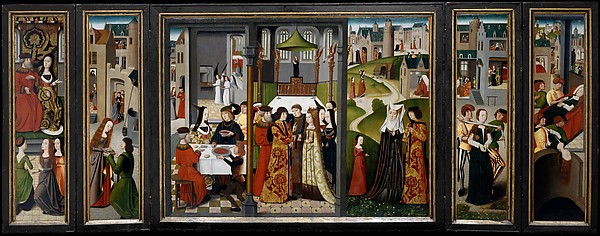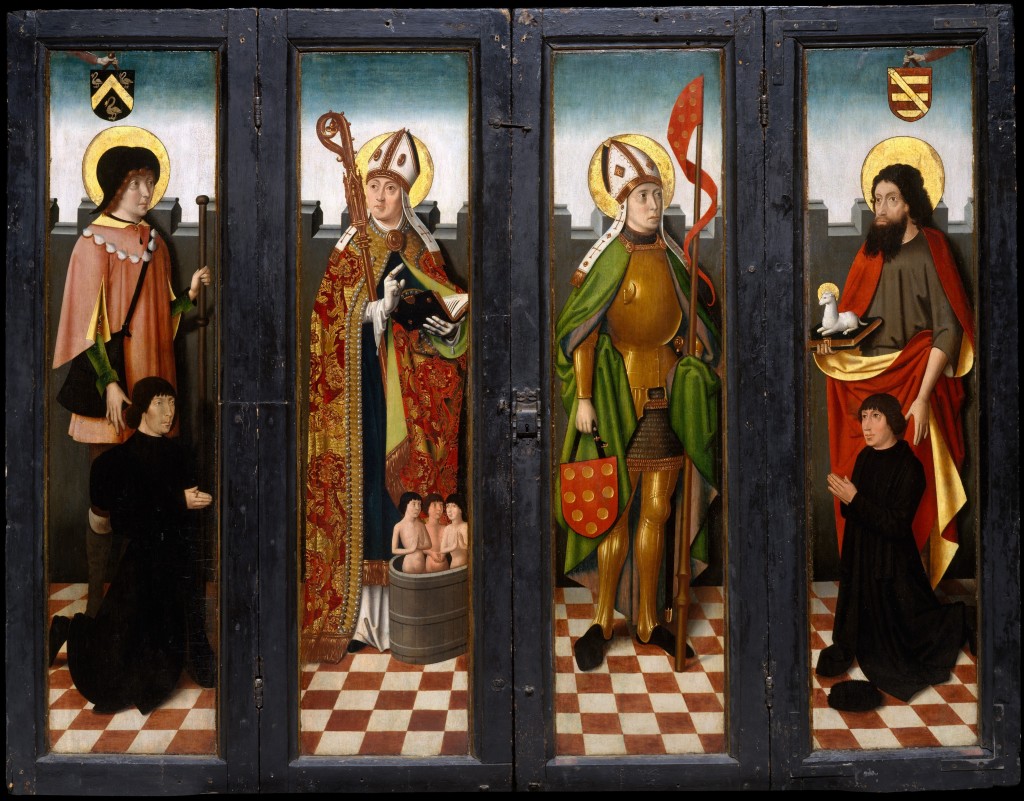A lot of my readers know that image on the cover of my novel, Pilgrimage, is a detail from a painting at the Metropolitan Museum of Art in New York City, a polyptych (that is to say, a panel painting that folds up) that had once been an altarpiece. The altarpiece as a whole is quite incredible, and shows scenes from the life (and death) of Saint Godeleva; in my novel, the mother of my heroine, Gebirga. The panel even includes images of the blind daughter who inspired Gebirga, so I was delighted to be able to use a part of it for the cover. Here it is in all its glory:

Well, not quite all its glory, as I discovered this evening. As an altarpiece, this polyptych would have hung behind and above the altar of a church. Polyptychs were designed to fold closed during Lent and other times of penance, concealing their beauty from the congregation. The closed doors of the polyptych would often have different painted scenes on their backs. You can see how this works in this link to the Ghent Altarpiece, which shows how it looks both open and closed.
It wasn’t until tonight that I discovered what was on the back of the doors of the Godeleva altarpiece. When closed, the four panels each show a different saint, with kneeling donor portraits in front of the saints on the far left and far right. Here is how it looks:

It was the two saints on the left who immediately caught my eye. I recognized them right away. The bishop in mitre and cope, holding his crook and a book was obviously Saint Nicholas, rescuing the three boys who had been chopped up and put in a barrel. Saint Nicholas, or at least his relics, play an important role in my novel. In their silver reliquary, they are Gebirga’s prized possession, carried with her on her journey until she relinquishes them so they can travel back to the Low Countries from Spain by boat. And as all Dutch children know, every year Saint Nicholas sails again from Spain around this time to reward them with treats. And the saint on the far left? The saint with staff, and pilgrim’s purse and hat, his neck ringed with scallop shells?
That is none other than Saint James, Sint Jaakob, Santiago himself.

Interesting. I note that the description from the museum identifies the left hand figure as St-Josse,. he is often depicted as a Pilgrim
Yes, I did a little bit of digging on that. Most (but not all) accounts of the painting describe that saint as Saint Josse (Judoc) and I think that is simply incorrect. Saint Judoc is usually shown bearded — so is James, but Judoc’s beard is more central to his myth because it was supposed to be eternally growing. More importantly, Saint Judoc travelled to Rome, not Compostela. The scallop shells indicate Compostela very clearly, so I don’t think there is any doubt it is James — especially since the painter of this polyptych painted two more polyptychs about the life and miracles of Saint James (I actually didn’t know this until after I posted this post, or I would have included it). There is a church in Bruges dedicated to James, and it was an important cult there at the end of the 15th century. The descriptions of this painting are not very reliable — they also dither over which Saint John is on the far right, and they interpret the narrative of the main panels in very different ways.
How wonderful to open the back of the doors at this time of year to give all insight into the depth of Christianity so long ago, often now forgotten. Thank you Lucy.
John
I’m not quite convinced! Reading about the iconography of St Josse (Judoc), there is mention of a crown at his feet -depicting renunciation of his lands and fortune in Austria. There seems to be a crown tucked under the sleeve of this pilgrim’s attire. Josse was also a popular devotion in the Low Countries.
Do you have any clues as to the coat of arms above the figure? This might help identification.